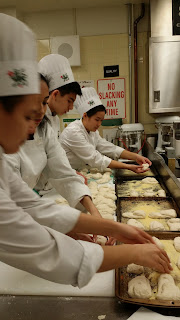Well, I said to my students, why not just aim for better everything? Let's get better meat, better bread, better condiments and better ... well, better everything.
Wassup Chef?
Wassup is one of the finest meals these students have made. Home-made ciabatta buns still warm from the oven, filled with house-slow-roasted brisket and caramelized sugar onions and sweet, sweet mustard from the sunny fields of Saskatchewan. "There are fancier meals somewhere", I told them, "but few better than what you're going to make." Let's go!
We started four days before our dinner, on Monday making starter (called 'Biga') for our ciabatta buns. Chefs Michael and Noah made it up for us, and gently stowed it in the bottom of an unused cupboard, at the back, in the dark.
How's that for tender care of your food? The biga couldn't be happier though ... it worked perfectly on Thursday.
On Wednesday we started making the brisket, with a group of chefs prepping all the vegetableswhich would surround the meat in a very slow oven. We piled it high with butternut squash, sweet potato, celery and onion chunks all tossed in a rosemary dressing with rather a lot of pepper and garlic added in.
Our brisket was sourced directly from the farm ... Dan Howell at HiLow Angus, on the very edge of the beautiful Qu'Apelle Valley in Saskatchewan, has a lovely herd of Black Angus cattle, and he raises them with great care. The brisket was from one of his excellent herd, and it was just a beautiful piece of meat to work with. Every chef should be so lucky!
The brisket was prepared by removing some of the larger bits of fat marbling (not needed for this dish)

 and putting on a dry rub of 2 parts coarse pepper to 1 part coarse salt. Chef Ren took care, working with Chef Tai,to get the dry rub well worked into the meat and kept the coverage even. Then the beast was put into a deep roasting pan on a wire rack, and entirely covered with the prepared veg and had a little stock added in (we make all our own stocks at Monarch Park, both brown and white stock). The whole pan was sealed up tight with tinfoil by Chefs Yuen Feng and Dan and put into a 200 degree oven (that is not a mis-print ... just two hundred degrees) for a long, slow roast of 24 hours. Then we cleaned up the kitchen and walked away to do something else.
and putting on a dry rub of 2 parts coarse pepper to 1 part coarse salt. Chef Ren took care, working with Chef Tai,to get the dry rub well worked into the meat and kept the coverage even. Then the beast was put into a deep roasting pan on a wire rack, and entirely covered with the prepared veg and had a little stock added in (we make all our own stocks at Monarch Park, both brown and white stock). The whole pan was sealed up tight with tinfoil by Chefs Yuen Feng and Dan and put into a 200 degree oven (that is not a mis-print ... just two hundred degrees) for a long, slow roast of 24 hours. Then we cleaned up the kitchen and walked away to do something else.=========== segue to the next day =============
Early on thursday Chef Karlye came into the kitchen at just after 07h00 to help make bread for everyone. By the time the rest of the brigade arrived the dough was made and the clean-up complete. The rising was finished at just after 09h20 and the dough was punched down, cut, rolled, formed and set out to proof.
Then ... time to check on our all-night science experiment (according to one doubting Thomas). Would the brisket be cooked? Would it even be edible? Would it taste good?
Out it came from the oven ... aaaaanndd ...
OMG that smells SO good Chef!
So we got to shredding it with plain old kitchen table forkswhile another group of chefs made 5 kg of caramelised sweet onions (Chef Brandon here showing excellent technique and focus) and Chef Sabrina dug up every type of mustard we had in the kitchen. We always feature Kozliks mustards here, and today added three delicious mustards (cranberry, green and a VERY hot) from Gravelbourg, Saskatchewan, to ensure that there was strong representation from The West.
We baked all the buns.
We set out our banquet in the kitchen in the area behind the hot line.
We sent Chef Jessica up to the room where a special group of students work in Monarch Park, and they are the ones who do our laundry 3 times a week. Jessica invited all of them, plus their teacher Mr Jay Arrington and the teaching assistants to come down and join us for a real home-made all-Canadian treat.
They came.
We lined up (sort of) and washed our hands.
My chef students served our guestsand helped them make their sandwiches ... then we all just quieted down and enjoyed delicious food, home-made, a treat in every way.
Dan Howell of HiLow Farm, thank you for the outstanding beef! I hope we did you proud. We always give special thanks to our farmers.
A particular thanks to Chef Jessica who, in addition to all her other duties, took all these pictures on Chef's phone.
A very special early-riser thanks to Chef Karlye, our 7 AM bread-maker. You made simply wonderful ciabatta Chef.
Have a good week-end everyone!

































